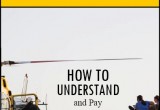Medical Bill Help Book Explains How to Appeal Denials
Online, May 21, 2011 (Newswire.com) - Nicholas Newsad, M.H.S.A., a former surgery center administrator and senior analyst of a national surgery management company, teaches patients how to appeal denied claims "internally" and "externally" in his new book Medical Bill Help. Medical Bill Help, published by the Westminster Cambridge Conglomerate, is the follow-up to Newsad's previous book, The Medical Bill Survival Guide.
"The Affordable Care Act of 2010 has created a uniform process for appealing denials across the country," Newsad says. "It is a shame that very few denied claims are appealed by patients because the denial overturn rate is actually pretty good. Of those that are not overturned during the "internal" appeal, up to 41% of those denials submitted to external reviews were decided in favor of the patient. Sadly, only a very small percentage of patients that were denied care appear to be exercising their right to external reviews."
In his new book, Newsad clarifies that there is a difference between the denial of a claim and the rejection of a claim.
"Claim rejections occur when a claim is not even processed by the health insurance company," says Newsad. "Rejections are 'kicked out' immediately after they are electronically uploaded and before any type of coverage determination is made. Rejections are cause by things like submitting incorrect policy numbers, enrollee numbers, patient birth dates, or sending the claim to the wrong insurance company. Rejections are resolved by simply re-submitting the correct information."
Newsad explains that true denials occur when the health insurance company receives and processes a claim, but determines that the treatment in question is not a covered benefit in the benefit plan. Denial codes on the insurance notices that come back will include a message like "service not a benefit in enrollee's plan", "denied for lack of medical necessity" or "denied coverage of experimental treatment". Newsad says denials can be appealed if a mistake has been made and a decent portion of denials are overturned.
Newsad says there is not a lot of information available on how frequently insurance companies reject and deny claims. One of the few legitimate studies of the frequency of denied and rejected claims was published in 2003 by the Health Insurance Association of America (HIAA) in their report "Results from an HIAA Study on Claims Payment Processes". This study of 26 million enrollees and 900,000 claims found that 14% of claims were denied or rejected.
Of this 14% of claims, 69% of those claims (9.7% overall) were rejected because of duplicate claims submitted for the same procedure, because the patients either did not have insurance coverage at the time at all, or because the incorrect information was submitted. When you exclude the rejections, Newsad says only about 4.3% of total claims were really denied.
In his book, Newsad also cites denial data from the American Medical Association (AMA), which represents physicians. According to the AMA's 2010 National Health Insurance Report Card (NHIRC), the average overall denial rate was about and 2.4% in 2010. The insurance company that actually denied the most physician claims in the 2010 study was actually Anthem at 4.5%.
External reviews and independent review organizations
Newsad explains that there is government oversight over the denial of healthcare insurance claims. The official term for a denied appeal is an "adverse benefit determination". One important provision of the 2010 Affordable Care Act (ACA) is that for the first time, all patients have right to appeal to an "external", third-party review organization, regardless of what state they live in or what type of health insurance they have. Prior to the enactment of the ACA, there were 44 states that had existing external review processes, but the scope of these review processes varied widely. The new federal law makes "internal" and "external" review processes uniform across all states and types of health insurance plans.
If a treatment you had was denied for coverage, you can always submit an "internal" appeal directly to the insurance company. You and your physician or provider should craft this review together based on the insurance company's medical underwriting guidelines, the uniqueness of your treatment, and any published literature supporting your case. If the health insurance company denies the "internal" appeal, you can request an "external" review and your state's health insurance commissioner will select an Independent Review Organization (IRO) to assess your case.
The intended purpose of an "external" review is primarily to provide a binding, independent judgment of whether the treatment was a covered benefit, medically necessary, or experimental. When you submit a request for an "external" appeal, the insurance commissioner of your state is responsible for assigning an (IRO) that is credentialed and qualified to render an opinion on your case. The IRO's decision is binding, so if they decide in your favor, the health insurance has to honor their decision by paying for your treatment.
It is not uncommon for an IRO to rescind the insurance company's decision. Up until 2006, the Association of Health Plans (AHIP) tracked how often IROs overturned health insurance denials. The number of overturned decisions was trending downward over the years, but as of the last year surveyed, IROs decided in favor of the patient, at least partially, in 41% of reviewed cases. Surprisingly, only about 1 out of 10,000 health plan members ever requested an external review. This is surprising because at 2.4% to 4.3% denials rates, it would be expected that at least a few hundred denials are rendered in a sample of 10,000 members. Clearly patients do not know that the can request external reviews.
Medical Bill Help is available from Amazon.com in the free "Kindle for PC" reader and on the Kindle.
